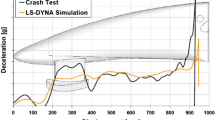Abstract
One of the most important requirements of the Formula SAE (Society of Automotive Engineers) race car design competition is that the car structure must guarantee a high protection level in case of frontal impacts, by preventing intrusions into the driver foot zone or dangerous deceleration levels. These functions are mainly performed by the impact attenuators, which have to guarantee a high specific energy absorption capacity (SEA) and in order to preserve vehicle performances, have to be as light weighted as possible. The aim of this study is the design of an impact attenuator, to be mounted on a Formula SAE car, which main purpose is to obtain the optimal crash energy management, maximizing the absorbed energy and optimizing the geometry. The outcome of the study highlights that the absorber structure made up of honeycomb sandwich panels (primary energy absorbers), realized by means of different aluminium alloys employing an innovative design considering particular geometrical cavities within the structure, could lead to reduce the overall weight and to achieve a more progressive deformation during the impact.
Similar content being viewed by others
References
2017–18 Formula SAE® Rules (2017). https://www.fsaeonline.com/content/2017-18-FSAE-Rules-091317.pdf
Ahmadisoleymani, S. S. and Missoum, S. (2017). Risk prediction of traumatic brain injury from car accidents. ASME 2017 Int. Mechanical Engineering Cong. and Expo. American Society of Mechanical Engineers Digital Collection.
Belingardi, G. and Obradovic, J. (2010). Design of the impact attenuator for a formula student racing car: numerical simulation of the impact crash test. J. Serbian Society for Computational Mechanics 4, 1, 52–65.
Boria, S. (2016). Numerical and experimental analysis of an impact attenuator in sandwich material for racing application, Int. J. Science, Engineering and Technology Research, 5, 6, 1909–1913.
D’Agostino, L., Bertocchi, L., Splendi, L., Strozzi, A. and Moruzzi, P. (2013). Optimization methodology for innovative automotive crash absorbers. ASME 2013 Int. Mechanical Engineering Cong. and Expo. American Society of Mechanical Engineers Digital Collection.
Kay, G. (2003). Failure modeling of titanium 6al-4v and aluminium 2024-t3 with the johnson-cook material model. U.S. Department of Transportation Federal Aviation Administration.
Johnson, G. R. and Cook, W. H. (1983). A constitutive model and data for metals subjected to large strains, high strain rates and high temperatures. Proc. 7th Int. Symp. Ballistics, Hague, Netherlands, 541–547.
Ma, D. and Lankarani, H. M. (1997). A multibody/finite element analysis approach for modeling of crash dynamic responses. J. Mechanical Design 119, 3, 382–387.
Plassard, P., Mespoulet, J. and Hereil, P. (2011). Hypervelocity impact of aluminium sphere against aluminium plate: experiment and LS-DYNA correlation. Proc. 8th European LS-DYNA Users Conf., Strasbourg, France.
Potabatti, N. S. (2016). Design and physical testing of impact attenuator for formula SAE racecar, Int. J. Science, Engineering and Technology Research 5, 1, 357–360.
Ruan, D., Lu, G., Wang, B. and Yu, T. X. (2003). In-plane dynamic crushing of honeycombs—a finite element study, Int. J. Impact Eng., 28, 2, 161–182.
Wu, E. and Jiang, W. S. (1997). Axial crush of metallic honeycombs, Int. J. Impact Eng., 19, 5–6, 439–456.
Yamashita, M. and Gotoh, M. (2005). Impact behaviour of honeycomb structures with various cell specifications—numerical simulation and experiment, Int. J. Impact Eng. 32, 1–4, 618–630.
Zhao, H. and Gary, G. (1998), Crushing behaviour of aluminium honeycombs under impact loading, Int. J. Impact Eng., 21, 10, 827–836.
Zhou, C., Jiang, L., Tian, K., Bi, X. and Wang, B. (2017). Origami crash boxes subjected to dynamic oblique loading. J. Appl. Mech. 84, 9, 091006–1–091006–11.
Acknowledgement
The authors would like to thank Eng. Andrea Milanese of the Politecnico of Milan for his support in the experimental activity and the Formula Sae team of University of Naples for the support in the prototypes realization.
Author information
Authors and Affiliations
Corresponding author
Additional information
Publisher’s Note
Springer Nature remains neutral with regard to jurisdictional claims in published maps and institutional affiliations.
Rights and permissions
About this article
Cite this article
Coppola, L., De Marco, B., Niola, V. et al. Impact Attenuator Optimum Design for a FSAE Racing Car by Numerical and Experimental Crash Analysis. Int.J Automot. Technol. 21, 1339–1348 (2020). https://doi.org/10.1007/s12239-020-0126-4
Received:
Revised:
Accepted:
Published:
Issue Date:
DOI: https://doi.org/10.1007/s12239-020-0126-4




